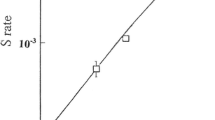Summary
In the course of this work a method of clonal analysis of transformed cells was developed. This involves growing of cells on nonselective plates, replication of colonies on selective agar to score for recombinants, homogenization of initial colonies and their analysis for pure or mixed progeny.
The main result of these experiments is the fact that pure clones are formed with a probability dependent on the specificity of the mutation involved. Proof is given that the pure clones are due to the repair of molecular heterozygotes formed during transformation.
Clonal analysis of double transformants gives an approach to the study of independent or simultaneous correction of molecular hets. Experiment shows in case of linked markers that simultaneous repair is overwhelming. When the distance between the markers becomes big enough we find a transition to independent correction of hets. The data are in general agreement with the results ofEphrussi-Taylor on transformation ofPneumococcus.
Similar content being viewed by others
References
Anagnostopoulos, C., and S. P.Crawford: Transformation studies on the linkage of markers in the tryptophan pathway inBacillus subtilis. Proc. nat. Acad. Sci. (Wash.)47, 378 (1961).
Bodmer, W. F.: Recombination and integration inBacillus subtilis transformation: involvement of DNA synthesis. J. molec. Biol.14, 534 (1965).
Bresler, S. E., R. A.Kreneva, V. V.Kushev, and M. I.Mosevitskii: The molecular mechanism of genetic recombination in bacterial transformation. Z. Vererbungsl.95, 288 (1964).
————: The mechanism of messenger-RNA replication in bacteria. J. molec. Biol.8, 79 (1964).
Bresler, S. E., A. S. Kriviskii, V. L. Kalinin, D. A. Perumov, andT. P. Chernic: Genetics (in press).
Burkholder, P. R., and N. H.Giles: Induced biochemical mutations inBacillus subtilis. Amer. J. Bot.34, 345 (1947).
Carr Wilson, M., J. H.Farmer, and F.Rothman: Thymidylate synthesis and aminopterin resistance inBacillus subtilis. J. Bact.92, 186 (1966).
Dubnau, D., C.Goldthwaite, J.Smith, and J.Marmur: Genetic mapping inBacillus subtilis. J. molec. Biol.27, 163 (1967).
Ephrati-Elizur, E., P. R.Srinivason, and D.Zamenhof: Genetic analysis by means of transformation of histidine linkage group inBacillus subtilis. Proc. nat. Acad. Sci. (Wash.)47, 56 (1961).
Ephrussi-Taylor, H. and T. C.Gray: Genetic studies of recombining DNA in Pneumococcal transformation. J. gen. Physiol.49, 211 (1966).
Farmer, J. H., and F.Rothman: Transformable thymine-requiring mutant ofBacillus subtilis. J. Bact.89, 262 (1965).
Fox, M. S.: On the mechanism of integration of transforming deoxyribonucleate. J. gen. Physiol.49, 183 (1966).
Freese, E. B., and E.Freese: Induction of pure mutant clones by repair of inactivating DNA alterations in phage T4. Genetics54, 1055 (1966).
Goodgal, S. M., and E. M.Postel: On the mechanism of integration following transformation with single-stranded DNA ofHaemophilus influenzae. J. molec. Biol.28, 261 (1967).
Holliday, R.: Mutation and replication inUstilago maydis. Genet. Res.3, 472 (1962).
Howard-Flanders, P., and R. P.Boyce: DNA Repair and Genetic recombination: Studies on mutants ofEscherichia Coli defective in these processes. Radiat. Res. Suppl.6, 156 (1966).
Kubitschek, H. E.: Mutation without segregation in bacteria with reduced dark repair ability. Proc. nat. Acad. Sci. (Wash.)55, 269 (1966).
Louarn, J.-M., and A. M.Sicard: Transmission of genetic information during transformation inDiplococcus pneumoniae. Biochem. biophys. Res. Commun.30, 683 (1968).
Nester, E.W., and B. A. D.Stocker: Biosynthetic latency in early stages of DNA transformation inBacillus subtilis. J. Bact.86, 785 (1963).
Okubo, S., and W. R.Romig: Impaired transformability ofBacillus subtilis mutant sensitive to mitomycin C and ultraviolet irradiation. J. molec. Biol.15, 440 (1965).
Venema, G., R. H.Pritchard, and T.Venema-Schroder: Properties of newly introduced transforming DNA inBacillus subtilis. J. Bact.90, 343 (1965).
Yoshikawa, H., and N.Sueoka: Sequential replication ofBacillus subtilis chromosome. I. Comparison of marker frequencies in exponential and stationary growth phases. Proc. nat. Acad. Sci. (Wash.)49, 559 (1963).
Author information
Authors and Affiliations
Additional information
Communicated byP. Starlinger
Rights and permissions
About this article
Cite this article
Bresler, S.E., Kreneva, R.A. & Kushev, V.V. Correction of molecular heterozygotes in the course of transformation. Molec. Gen. Genet. 102, 257–268 (1968). https://doi.org/10.1007/BF00385983
Received:
Issue Date:
DOI: https://doi.org/10.1007/BF00385983




